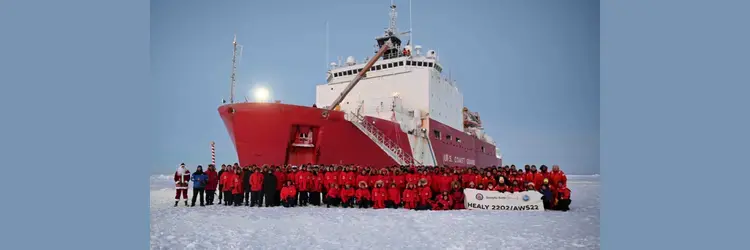
U.S. Coast Guard photo by Deborah Heldt Cordone, Auxiliary Public Affairs Specialist 1
2022 Synoptic Arctic Survey Cruise on USCGC Healy
On September 30, 2022, the USCGC Healy, her crew, and a team of NSF funded scientists reached the North Pole for the third time in the ship's career (and the second time unaccompanied). This is a significant accomplishment both for the ship and for US science.
The mission was conducted as part of the international Synoptic Arctic Survey Program (SAS)
The team of scientists on board Healy are funded by the National Science Foundation to measure key physical oceanographic, ecosystem, and carbon system parameters to establish a baseline for this region of the Arctic Ocean. The on-board team is comprised of SAS principal investigators as well as undergraduate and graduate students, postdoctoral investigators, technicians, marine mammal and seabird observers, and a photographer and includes both US and international scientists.
Research areas covered by the team cover physical oceanography (hydrography, current), atmospheric drivers, mesozooplankton and macrobenthic distributions and ecology, marine mammal and seabird observations, water column and sediment chlorophyll, water column nutrients, water column d18O, seawater carbonate chemistry, dissolved gas tracers, rates of water column photosynthesis, respiration and net community production, water column particulate carbon and nitrogen content and optical properties, and water column and air methane content. Sampling included CTD/Niskins, plankton nets (Bongo, Multinet), large volume pumps, benthic grabs and corers (Van Veen, MultiHaps, MultiCore), and Video Plankton Recorder. The cruise track lies roughly along the tracks covered by the 2015 GEOTRACES cruise and 1994 Trans Arctic Section, with some digressions. Stations were widely spaced along the cruise track in order to accommodate the long sampling period required at each location as well as steady progression along the planned track lines. Bad weather precluded sampling at some planned locations/latitudes.
The team was struck by how relatively easily the ship traversed the ice and reached the North Pole. For much of the track, the ice was unexpectedly (to us) thin with multiple leads that permitted easy transit. This was in part because of favorable south winds during some periods but also because the ice itself was not particularly thick. There were some latitudes where bands of heavy ice impeded northward progress (e.g., 86-87°N) but overall multiple leads hastened progress, even nearing the Pole where miles long leads extending N-S provided a "road" to our goal. During the cruise, the team sampled along the Chukchi shelf-break and slope, Chukchi Borderlands and Northwind Ridge, and in the Canada, Amerasian, Amundsen, and Makarov Basins. The data and samples collected will be a significant contribution to our understanding of the present states of these regions and, where possible, to how conditions may have changed since the last time that these regions were visited.
Several of the science team (Ashjian, Campbell, Grebmeier, Cooper, Bates) worked from the USCGC Healy in her early years of service during the NSF funded Shelf Basins Interaction Program and have continued to work from the ship on multiple later cruises. This long association allows us the opportunity to reflect on the significant contributions that the ship, and the USCG, have made to fundamental understanding of the Arctic Ocean and to establishing and furthering US prominence in Arctic Science.
SAS PIs: Carin Ashjian (Co-Chief Scientist; Woods Hole Oceanographic Institution), Jackie Grebmeier (Co-Chief Scientist; University of Maryland), Nick Bates (Bermuda Institute of Ocean Sciences), Robert Campbell (University of Rhode Island), Lee Cooper (University of Maryland), Seth Danielson (University of Alaska Fairbanks), Laurie Juranek (Oregon State University), Cindy Pilskaln (University of Massachusetts), and Mary-Louise Timmermans (Yale University). Additional PIs: Cedric Magnon (University of Maryland), Sue Moore (University of Washington), and Elizabeth Labunski (US Fish and Wildlife Service).